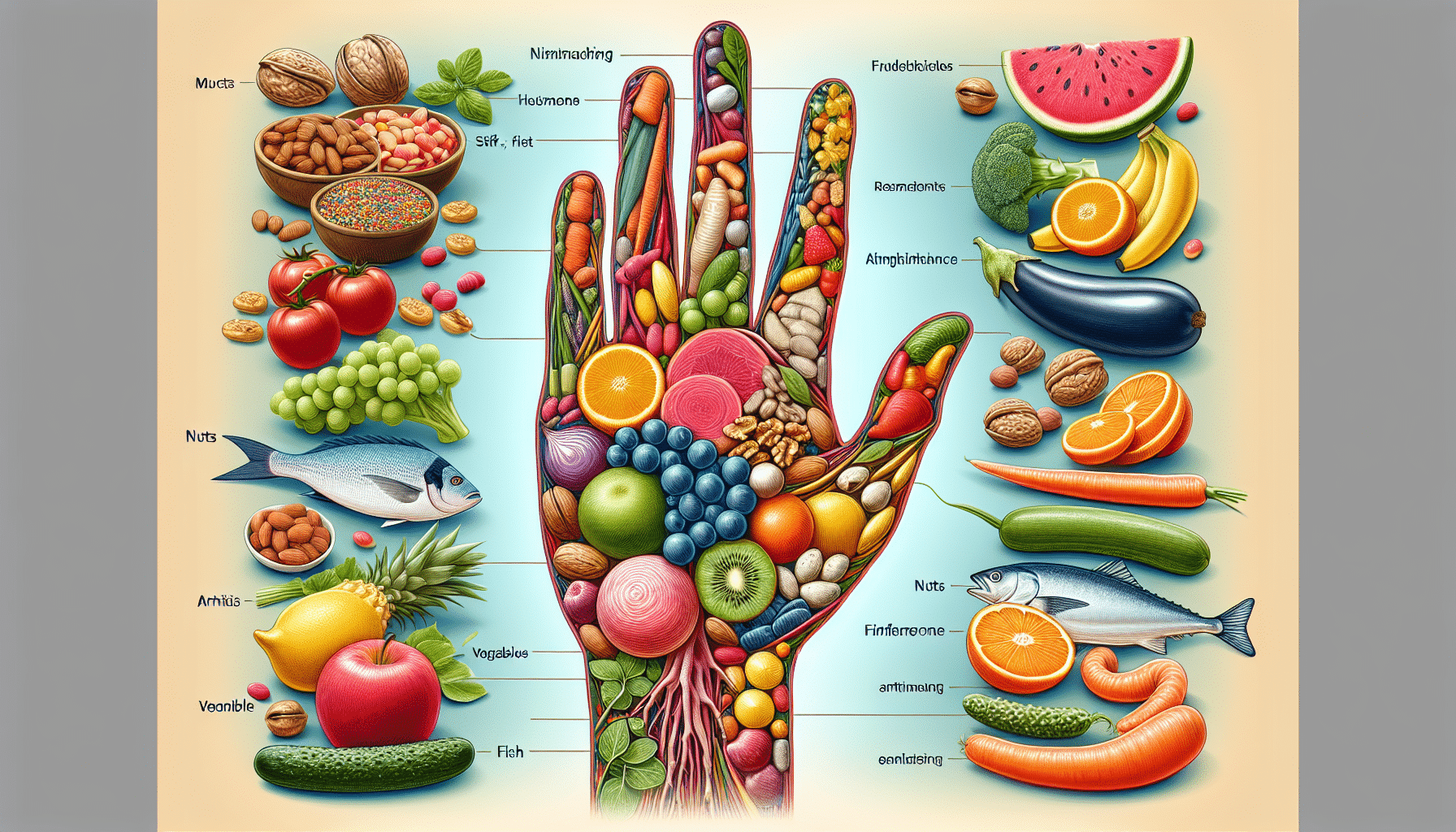
Living with arthritis can be challenging, but there are daily habits you can adopt to help ease the pain and manage your symptoms effectively.
In this article, we will explore five simple yet effective habits that can provide relief from arthritis pain. By incorporating these habits into your daily routine, you can take control of your pain and improve your quality of life. Say goodbye to constant discomfort and hello to a more manageable and pain-free existence.

This image is property of images.pexels.com.
Exercise
Regular exercise is an essential part of managing arthritis pain and improving overall joint health. There are several types of exercises that can provide relief for arthritis pain.
Types of exercises for arthritis pain relief
Low-impact exercises such as walking, swimming, and cycling are highly recommended for individuals with arthritis. These exercises help improve flexibility, strengthen muscles, and reduce joint stiffness. Range-of-motion exercises, such as yoga and tai chi, can also be beneficial for increasing joint mobility and reducing pain. Additionally, strength training exercises help support the joints and prevent further damage.
Benefits of exercise for arthritis pain management
Engaging in regular exercise offers a myriad of benefits for individuals with arthritis. Exercise helps to alleviate pain, decrease inflammation, and improve joint function. It also aids in maintaining a healthy weight, which is crucial for reducing stress on the joints. Regular physical activity can also improve sleep quality, boost mood, and enhance overall well-being.
Tips for incorporating exercise into daily routine
If you’re new to exercise or have been sedentary for some time, it’s important to start slowly and gradually increase the duration and intensity of your workouts. Begin with gentle exercises and gradually progress to more challenging activities. It’s also crucial to listen to your body and not push yourself too hard. Find activities that you enjoy so that you can stay motivated and make exercise a regular part of your daily routine. Consult with a healthcare professional or physical therapist to develop an exercise plan that is safe and customized to your individual needs.
Maintaining a Healthy Weight
Maintaining a healthy weight is vital for individuals with arthritis as excess weight can significantly worsen joint pain and inflammation.
The impact of weight on arthritis pain
Carrying extra weight puts additional stress on weight-bearing joints such as the knees and hips, leading to increased pain and reduced mobility. Moreover, excess adipose tissue produces inflammatory substances that can exacerbate arthritis symptoms and contribute to joint damage.
Strategies to achieve and maintain a healthy weight
To achieve a healthy weight, it is important to adopt a well-balanced diet and engage in regular physical activity. Incorporate plenty of fruits, vegetables, lean proteins, and whole grains into your diet while limiting the consumption of processed foods and sugary drinks. Aim to engage in at least 150 minutes of moderate-intensity aerobic exercise per week, such as brisk walking or swimming. Consider incorporating strength training exercises to build muscle mass and increase your metabolism.
Dietary considerations for weight management
When managing weight for arthritis pain relief, it is important to choose foods that support joint health. Omega-3 fatty acids found in fatty fish, such as salmon and mackerel, have anti-inflammatory properties that can help reduce joint pain and swelling. Additionally, incorporating foods rich in antioxidants, such as berries and leafy greens, can help combat inflammation. Avoid foods high in saturated fats and trans fats, as they can contribute to inflammation and weight gain.

This image is property of images.pexels.com.
Dietary Modifications
Making dietary modifications can play a significant role in managing arthritis pain and reducing inflammation.
Foods to include in an arthritis-friendly diet
An arthritis-friendly diet should include foods that are rich in nutrients and have anti-inflammatory properties. Some beneficial foods include fatty fish, such as salmon and tuna, which are high in omega-3 fatty acids. Other foods like walnuts, chia seeds, and flaxseeds also provide omega-3s. Additionally, incorporating fruits and vegetables, whole grains, lean proteins, and healthy fats like olive oil and avocado can help reduce inflammation and improve overall joint health.
Foods to avoid for reducing arthritis pain and inflammation
Certain foods can trigger inflammation and worsen arthritis pain. It is important to limit or avoid foods that are high in saturated fats, trans fats, refined sugars, and processed carbohydrates. These include fried foods, sugary snacks, white bread, and sugary drinks. It is also advisable to reduce consumption of red meat and processed meats, as they may contribute to inflammation.
The role of supplements in managing arthritis pain
Supplements may be beneficial for individuals with arthritis, but it is important to consult with a healthcare professional before starting any supplements. Omega-3 fatty acid supplements have been shown to have anti-inflammatory properties and may help reduce joint pain. Glucosamine and chondroitin sulfate supplements may also provide relief for some individuals. However, it is important to note that not all supplements are backed by scientific evidence, so it is crucial to discuss their potential benefits and risks with a healthcare professional.
Hot and Cold Therapy
Hot and cold therapy can provide temporary relief from arthritis pain by reducing inflammation and soothing joint discomfort.
Using heat therapy for arthritis pain relief
Heat therapy, such as applying warm towels or using heating pads, can help relax muscles and increase blood flow to the affected joints. This, in turn, helps reduce stiffness and alleviate pain. Heat therapy is particularly effective for individuals with osteoarthritis or stiff joints.
Applying cold therapy to reduce inflammation and swelling
Cold therapy, such as using ice packs or cold compresses, can help reduce inflammation and swelling in the joints. Cold temperatures numb the area and constrict blood vessels, which can help alleviate pain and reduce inflammation. Cold therapy is particularly effective for individuals with rheumatoid arthritis or acute joint inflammation.
Alternating between hot and cold therapy for maximum benefits
Some individuals find alternating between hot and cold therapy beneficial for managing arthritis pain. This can be done by applying heat therapy for 15-20 minutes followed by cold therapy for 10-15 minutes. The hot-cold contrast helps boost circulation, reduce inflammation, and provide relief from joint discomfort.

This image is property of images.pexels.com.
Managing Stress
Stress can worsen arthritis pain and impact overall health and well-being. Implementing stress-management techniques can be crucial for managing arthritis pain effectively.
The connection between stress and arthritis pain
Stress triggers the release of stress hormones, which can increase inflammation and intensify arthritis symptoms. Furthermore, stress can lead to muscle tension, decreased pain tolerance, and disrupted sleep, all of which can contribute to increased discomfort.
Techniques to reduce stress for arthritis pain relief
Engaging in stress-relieving activities can help reduce arthritis pain. Deep breathing exercises, meditation, and gentle stretching can promote relaxation and reduce stress levels. Engaging in hobbies, such as painting or gardening, can also provide a sense of calm and distraction from pain. Additionally, seeking support from loved ones or joining support groups can help alleviate stress by providing emotional support and a sense of belonging.
Incorporating relaxation practices into daily routine
Incorporating relaxation practices into your daily routine can be highly beneficial for managing stress and arthritis pain. Set aside time each day for activities that promote relaxation, such as taking a warm bath, listening to soothing music, or practicing mindfulness. Creating a serene environment in your home, with soft lighting and comfortable surroundings, can also contribute to a sense of calm and well-being.
Assistive Devices and Adaptations
Using assistive devices and making adaptations to daily activities can greatly reduce the strain on arthritic joints and minimize pain.
Types of assistive devices for easing arthritis pain
There are various assistive devices available that can help individuals with arthritis perform daily activities with less discomfort. Examples include canes, crutches, and walkers, which provide stability and support while walking. Additionally, ergonomic utensils and tools with larger handles can make gripping and performing tasks easier. Braces or splints can also provide added support to joints, alleviating pain and reducing strain.
Adaptations to make daily activities less painful
Simple adaptations to daily activities can make a significant difference in reducing arthritis pain. For example, using jar openers or electric can openers can reduce strain on hand and wrist joints. Leveraged tools can make gripping and turning easier. Modifying furniture height or incorporating cushions and pillows for added support can also make sitting and standing more comfortable.
Finding the right assistive devices and adaptations for individual needs
It is important to consult with a healthcare professional or occupational therapist to determine the most suitable assistive devices or adaptations for individual needs. They can provide guidance on selecting the right devices and offer recommendations based on specific symptoms and limitations. Additionally, they can provide instructions on using the devices correctly to ensure optimal pain relief and improved functionality.
Medication and Treatment Options
Various medications and treatment approaches are available to help manage arthritis pain and improve quality of life.
Types of medications commonly prescribed for arthritis pain
Nonsteroidal anti-inflammatory drugs (NSAIDs) are often prescribed for relieving arthritis pain and reducing inflammation. These medications can help alleviate both the pain and inflammation associated with arthritis. In some cases, healthcare professionals may recommend corticosteroids to reduce inflammation and provide quick relief. Additionally, disease-modifying antirheumatic drugs (DMARDs) and biologic agents may be prescribed to slow disease progression in certain types of arthritis.
Alternative and complementary treatment approaches
In addition to conventional medication, there are alternative and complementary treatment approaches that can provide relief for arthritis pain. Physical therapy can help improve joint function and strengthen muscles supporting the affected joints. Acupuncture, massage therapy, and chiropractic care may also offer pain relief for some individuals. It is important to discuss these options with a healthcare professional to determine their suitability and safety.
Working with healthcare professionals to find the most suitable treatment plan
Collaborating with healthcare professionals is essential for developing a comprehensive treatment plan. They can evaluate your symptoms, perform diagnostic tests, and recommend appropriate medications or treatments. They will take into consideration your medical history, lifestyle, and preferences to create a personalized treatment plan that addresses your specific needs. Regular follow-ups with healthcare professionals are crucial to monitor the effectiveness of the treatment plan and make any necessary adjustments.
Maintaining a Good Sleep Routine
A good night’s sleep is crucial for managing arthritis pain and promoting overall health and well-being.
The importance of sleep for managing arthritis pain
Quality sleep allows the body to repair and rejuvenate, which is especially important for individuals with arthritis. Lack of sleep can exacerbate pain, increase fatigue, and decrease overall function. Moreover, poor sleep can negatively impact mood, concentration, and overall quality of life.
Tips for improving sleep quality
Establishing a regular sleep routine can significantly improve sleep quality. Aim for a consistent sleep schedule, going to bed and waking up at the same time each day. Create a relaxing bedtime routine by engaging in activities such as reading or taking a warm bath before going to sleep. Ensure your sleep environment is quiet, dark, and comfortable, with a supportive mattress and pillows. Avoid stimulants such as caffeine or electronic devices close to bedtime, as they can interfere with sleep.
Creating a comfortable sleep environment
Creating a comfortable sleep environment is essential for promoting restful sleep. Ensure your bedroom is cool, well-ventilated, and free from excessive noise or distractions. Invest in a comfortable mattress and pillows that provide adequate support for your joints. Consider using blackout curtains or an eye mask to block out any unwanted light. Using white noise machines or earplugs can also help drown out any disruptive sounds, promoting uninterrupted sleep.

Joint Protection Techniques
Implementing joint protection techniques can help minimize stress on arthritic joints and prevent further damage.
Understanding joint protection and its benefits
Joint protection involves adopting strategies to reduce joint stress and minimize pain while performing daily activities. By implementing good joint protection techniques, individuals can reduce the risk of joint damage and maintain functionality. Additionally, properly protecting the joints can lead to reduced pain and increased mobility.
Proper body mechanics for reducing joint stress
Practicing proper body mechanics is crucial for reducing joint stress. When lifting or carrying objects, it is important to use larger, stronger joints whenever possible and avoid unnecessary bending and twisting. Maintain a good posture throughout the day, avoiding slouching or hunching. Modify activities to reduce joint strain, such as using supportive devices or tools to minimize repetitive motions.
Using assistive devices and modifications to protect joints
Assistive devices and modifications can greatly aid in joint protection. Using braces, splints, or support wraps can provide stability and support to painful joints. Ergonomic tools with larger handles can make gripping and performing tasks easier and decrease strain on the joints. Modifying the environment to reduce the need for repetitive motions or excessive bending can also contribute to joint protection.
Educating Yourself and Seeking Support
Arthritis education and seeking support are essential components of effectively managing arthritis pain.
Importance of arthritis education for pain management
Understanding the nature of arthritis and its impact on the body can empower individuals to make informed decisions regarding their pain management. Learning about the different types of arthritis, their symptoms, and the available treatment options can help individuals take an active role in their healthcare. Arthritis education can also provide a sense of control and reduce anxiety related to pain.
Joining support groups and connecting with others
Joining support groups or connecting with others who have arthritis can provide valuable emotional support and practical advice. Sharing experiences and learning from others who are going through similar challenges can be highly beneficial. Support groups can offer a sense of community, validation, and motivation to stay proactive in managing arthritis pain.
Educational resources and professional assistance
There are various educational resources available that can provide valuable information about arthritis management. Online resources, books, and reputable websites are excellent sources of information. It is important to verify the credibility of the source and consult with healthcare professionals for personalized advice. Healthcare professionals, such as rheumatologists and physical therapists, can further assist in understanding arthritis and guide individuals in developing a comprehensive pain management plan.







